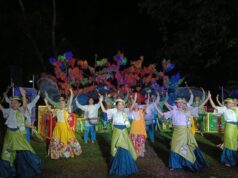“The mean age of the Filipino farmer is 54. Over a tenyear period, those in the age bracket 40 to 59 years old increased by seven percent and those 60 and above by two percent,” they said.
On the sidebar, Pampanga has the highest mean age, which is 61. The oldest, though, was found in Quezon province, who was 94 years old, and that two in Nueva Ecija were 91 years old.
However, due to “positive factors”, like the Department of Agriculture’s stance of allocating almost half of its budget in the rice program, college graduates have been attracted to rice farming.
Models of diversification in rice farming for optimum incomes, like the “Palayaman System”, have enticed them to this age-old occupation.
The system, from the words palay (rice) and yaman (wealth), is a high level integration of rice with other high-value crops and trees, fish, poultry, livestock and biomass recycling in a piece of land. Its key concept is the use of available farm resources and their interconnections.
Take these as examples: Glen Mandac of San Mateo, Isabela is a bona fide veterinarian.
Instead of seeking employment, he plunged into rice farming. Today, at 47, he is happily, and beneficially, tending his three-hectare farm for rice and mung bean production along with raising hogs, native chicken, and ducks, and managing his 50 fruit-bearing rambutan trees.
His son, Jasper Neil, is in a ladder-type course in agriculture and is intending to go into rice farming also.
In Barangay Malayantoc, Sto. Domingo, Nueva Ecija, Jonathan Gamilla, 27, finished a degree in agriculture. He went into rice farming, working on the land his father Angelito gave him which was part of the farmland acquired thru farming.
Like his father, Jonathan is into producing commercial rice and rice seeds.
“If not for rice farming, we could not have attained a breezy life today,” Jonathan said.
Glen and Jonathan are among the increasing number of college graduates lured into rice farming. Aside from them, a big number of high school graduates are now into rice farming. They have changed the profiles of rice farmers who for years were dominated by elementary grades graduates or drop-outs.
The study said that about one-fifth of the farmers who are less than 50 years old have at least a college education.
“For the educated farmers, we surmised that they decided to engage in rice farming because they knew it is a profitable enterprise,’’ the researchers said. “They have higher gross income compared with their counterparts with lower educational attainment,” they added.
The average income advantage of farmers with college education over those with lower educational attainment was 40 percent, they said.
In the 2006-2007 survey, the following incomes in a hectare by educational attainment of the rice farmers were recorded: elementary – P53,908.11; secondary – P74,085.02; collegiate – P99,643.79.
One other big factor for positive developments in rice farming was the announcement made by Agriculture Secretary Emmanuel Piñol regarding the rolling out of P30 billion package for rehabilitation of the agricultural-fisheries sector. The assistance will be in the form of farm inputs, like fertilizers and seed. The inputs and labor cost make production of one kilogram of palay very high, in fact highest in Asia.
For a kilogram production of rice, the cost in the country is P10.66, followed by China, P 10.50; and Indonesia, 10.11. Thailand, India and Vietnam, have lower cost of rice production at P8.84, India, P6.30; and Vietnam, P 6.30.
The planned scrapping of irrigation service fee announced by Pres. Duterte and Piñol is also deemed as a factor in making rice farming less expensive.
NIA collects irrigation service fees at the following rates: 2.5 cavans (50 kilograms each) per hectare during the wet season and 3.5 cavans for the dry season. At P17, which is the government support price per cavan, these translate to P2,125 a hectare during the wet season and P2,975 a hectare during the dry season.
Getting out of poverty
Many farmers, particularly those in “graying stage”, were noted hiring kasugpong.
“The farmers’ hired laborers or kasugpong increased from four percent to 13 percent,” the study said. “This new force enabled them to rent land, thereby expanding their rice farms,” it added.
“Present-day landlords” have also made the number of kasugpong, who are paid ten percent of the gross harvest, rise.
These moneyed “new landlords” acquired the lands from land reform benefi ciaries under the sanglang buhay or sanglang patay agreement.
Under sanglang buhay, the pawn broker requites ten to 15 per hectare per cropping. In the sanglang patay, no recompense is made. The sanglaan rate is from P500,000 to P700,000 per hectare.
For farmers who have next of kin working abroad, capitalization for farm operations is not a burden anymore. Remittances veered them away from informal lenders or lending institutions.
Others get capitalization from their cooperatives.
The use of hybrid rice varieties is another factor that makes farming attractive, the study said. It accords farmers harvest at least 150 cavans per hectare, with some chalking up harvest of up tgo more than 300 cavans.
“Definitely, there are handsome benefits to rice farming now,” the researchers said. “With some more yield increases and income diversification, it can give enough push to make farmers break away from poverty over time,” they said.




